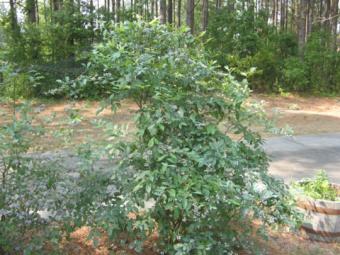
It's easy to learn how to grow blueberries organically, if you can provide the right soil conditions. Blueberries are frost tolerant perennial plants that look attractive in the garden in all seasons. They are available as semi-dwarfs and can also be grown in containers. Blueberries like very acidic soil, so the more naturally acidic your soil is, the fewer amendments you'll need to add in order to make blueberries at home in your garden.
Introduction to How to Grow Blueberries Organically
The highbush blueberry (Vaccinium corybosum) is an upright shrub that grows from six to 12 feet. It is the most commonly cultivated blueberry variety sold in the U.S. A native woodland plant that usually flourishes in moist peat, blueberries need special soil conditions in order to thrive in the home garden. Although many garden shrubs require neutral to slightly acidic soil conditions, blueberries need very acidic soil. They also benefit from humus-rich conditions and good light. Blueberries are self-pollinating, but some cross-pollination will help create more robust, larger berries.
Blueberries and Acidic Soil
One of the biggest challenges of growing blueberries organically is to provide consistently acidic soil. Soil acidity and alkalinity is measured on a scale of soil pH from 1 to 14. The lower the number is, the more acidic the soil will be. The higher the number is, the more alkaline the soil will be. A pH of 7.0, the median point on the scale, is neutral. Most home garden plants will have a soil pH that hovers around the neutral to slightly acid or alkaline mark. Blueberries, because they come from naturally acidic woodland areas, need a pH between 4.0 and 5.0, a very acidic range.
Creating the right organic soil conditions for blueberries can be challenging, and the measures you take to establish conditions favorable for blueberries will have to be maintained as long as you have them in your garden. This will likely mean periodic testing and the addition of acidifiers.
Preparing Soil For Blueberries
The first step to keeping healthy blueberry plants is to discover what your soil pH actually is. That way you'll have an idea of how much modification your existing soil will have to undergo. Your local agricultural extension office may be able to help you with that, or you can invest in a soil testing kit. One common practice is to use sulfur (s) to acidify soil, but it isn't the only option. The following list of organic additives will all make your soil more acidic:
- Vinegar
- Sawdust
- Peat moss
- Cottonseed meal
- Wood chips
- Leaf mold
- Coffee grounds (Be sure to compost them first.)
- Tea
Most of these measures will take a while to be effective, so consider preparing your soil for blueberries a couple of months in advance of buying plants. Blueberries go dormant in the fall and can be planted out then, so prepare your soil in spring for a fall planting.
When you plant your blueberry patch, remember that changing the soil's pH will affect other plants in the vicinity, so plan on adding only acid loving plants to the area.
Other Considerations
If you have heavy clay soil, lighten it with peat and sand. Blueberries also like lots of organic matter, so why not start a compost pile while you're at it. Even if you don't have room outside, you can create worm compost indoors in a small plastic tub. It's an organic solution that will feed your blueberries and other garden plants. With a little time and some patience, you can learn how to grow blueberries organically and harvest your own juicy blueberry crop every season.







